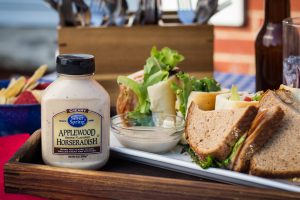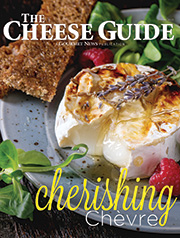Who Knew Wisconsin Was Horseradish Heaven?
By Lorrie Baumann
Imagine yourself up a thick roast beef sandwich on a crusty French roll with a slab of an aged Alpine-style cheese from Wisconsin – I’ll let you pick which one – maybe a slice of Beefsteak tomato and a really good dab of a nice horseradish mustard.
Sit on that a while. Hungry yet?
Now, still in your imagination, take away the horseradish. Missing something?
It is very likely that you owe that zing to Silver Spring Foods and to Eric Rygg, the company’s President and a fourth-generation member of the family-owned company founded by his great-grandfather, Ellis Huntsinger. He started the company after his business selling lightning rods door-to-door fell victim to the Great Depression, and he needed something to fall back on, and he needed it in a hurry. He turned to his farm for something else he could sell even in the midst of widespread financial collapse. “He grew melons and sweet corn and strawberries and horseradish,” Rygg says. “The product they were able to harvest was great but very seasonal. He was looking for something he could sell in the winter months.”
 Horseradish comes from a root from a plant that grows well in Eau Claire, Wisconsin, which is where Silver Spring Foods is located today as the world’s largest grower and processor of horseradish. The company’s product range has expanded since those early days to encompass more than 100 condiment products, some with a zing that comes from sriracha, some with a bite from chile peppers, some with a wow from wasabi, and of course, a whole range of sauces that get their zip from horseradish. They include Horseradish Steak Sauce, Cranberry Horseradish, the best-selling Beer ‘n Brat Mustard, Jalapeno Mustard and Chipotle Mustard as well as its newest product, Applewood Smoke Flavored Horseradish Sauce. “We may very well be the largest grower or the largest processor, but definitely the largest grower and processor because it’s very rare to do both,” he said. “We got our
Horseradish comes from a root from a plant that grows well in Eau Claire, Wisconsin, which is where Silver Spring Foods is located today as the world’s largest grower and processor of horseradish. The company’s product range has expanded since those early days to encompass more than 100 condiment products, some with a zing that comes from sriracha, some with a bite from chile peppers, some with a wow from wasabi, and of course, a whole range of sauces that get their zip from horseradish. They include Horseradish Steak Sauce, Cranberry Horseradish, the best-selling Beer ‘n Brat Mustard, Jalapeno Mustard and Chipotle Mustard as well as its newest product, Applewood Smoke Flavored Horseradish Sauce. “We may very well be the largest grower or the largest processor, but definitely the largest grower and processor because it’s very rare to do both,” he said. “We got our  start in horseradish, and we continue to do horseradish, but we do a lot of other things, too.”
start in horseradish, and we continue to do horseradish, but we do a lot of other things, too.”
Ellis Huntsinger’s worthy descendants tend to believe that any sandwich has a better bite to it if it bites back a bit. “My horseradish roots run deep,” Rygg says with a straight face – he’s got a whole bunch of those lines, collected through the generations, so you don’t necessarily want to get him started down that road. That sandwich idea is his, too – he’s scheming just now to persuade Eau Claire’s chefs to come up with a recipe for a sandwich that the city can adopt as its signature contribution to culinary history in much the same way that Philadelphia is firmly identified with the Philly Cheesesteak. He doesn’t yet know what that sandwich is going to be – that’s up to the community – but he’s sure that it ought to have horseradish and a slice of a beautiful Wisconsin cheese. Probably roast beef, and there’ll be some kind of bread. But definitely horseradish. “No roast beef sandwich left behind,” Rygg says. “With horseradish, we’re in a great position to do that. I just think about all those sandwiches out there that don’t have that great combination.”
As married as Rygg thinks horseradish is to roast beef, it also has a long history of fooling around – very publicly – with shrimp. Horseradish is used most often in seafood cocktail sauces, and Silver Spring Foods has a thriving private-label and co-packing business, so odds are that if you’ve enjoyed that dollop of cocktail sauce the last time you ordered a shrimp cocktail or you tasted a little extra zip in your Bloody Mary, that came from Silver Spring Foods. “Our mission is to make food taste better. We say that we bring excitement and flavor to food,” Rygg says. “We believe that horseradish
gives the food we love the extra zing it needs to go from traditional to traditional with a twist. Without adding sugar or fat, it’s like free flavor.”
Under his leadership, the company now has its sights set on expanding its reach into the specialty foods market with products like the Cranberry Horseradish, and Applewood Smoke Flavored Horseradish, which Rygg says is his current favorite among the product line. He ascended to the company presidency in October of this year after an apprenticeship that started with work in the horseradish fields while he was in high school and continued through his presidency of Kelchner’s, a company subsidiary known in the mid-Atlantic states for seafood sauce, while he was studying business in graduate school. He likes that Applewood Smoke Flavored Horseradish on a turkey sandwich with lettuce and tomato and maybe some avocado, but the sauce has the versatility to work in a variety of recipes. “It’s really good with everything – roast beef sandwiches, seafood, mixed into mashed potatoes, or over vegetables,” Rygg says. “It’s really starting to catch on in the market now. Smoke flavors are hot.”
“Before launching that, I would have said the Beer ‘n Brat Mustard,” he adds. “It’s not for amateurs. It’s pretty hot.”
The Beer ‘n Brat Mustard, like other horseradish products, gets its heat from a naturally occurring chemical called allyl isothiocyanate. It’s produced by an enzyme-catalyzed chemical reaction that occurs naturally as soon as the plant’s roots are crushed in the air – the plant’s natural defense from being eaten by rooting wildlife – we’re looking at you, pigs. \
There’s a reason why most of us leave our handling of raw horseradish roots to the professionals, and allyl isothiocyanate is it. Its potency is at its maximum when the roots are first crushed, tapering off slowly as the reaction’s raw materials are exhausted. The addition of a little vinegar when the sauce’s heat level is just right interrupts the reaction, giving the sauce a shelf life of up to six months. As Ellis Huntsinger himself discovered, the addition of a little cream to the horseradish sauce moderates the reaction to give it just a little extra shelf life, but either way, the clock on the sauce’s heat starts ticking as soon as the horseradish root is crushed, so a horseradish sauce is best enjoyed within six months of its production.
For further information, visit www.silverspringfoods.com.








